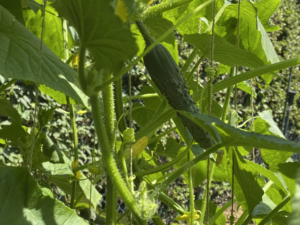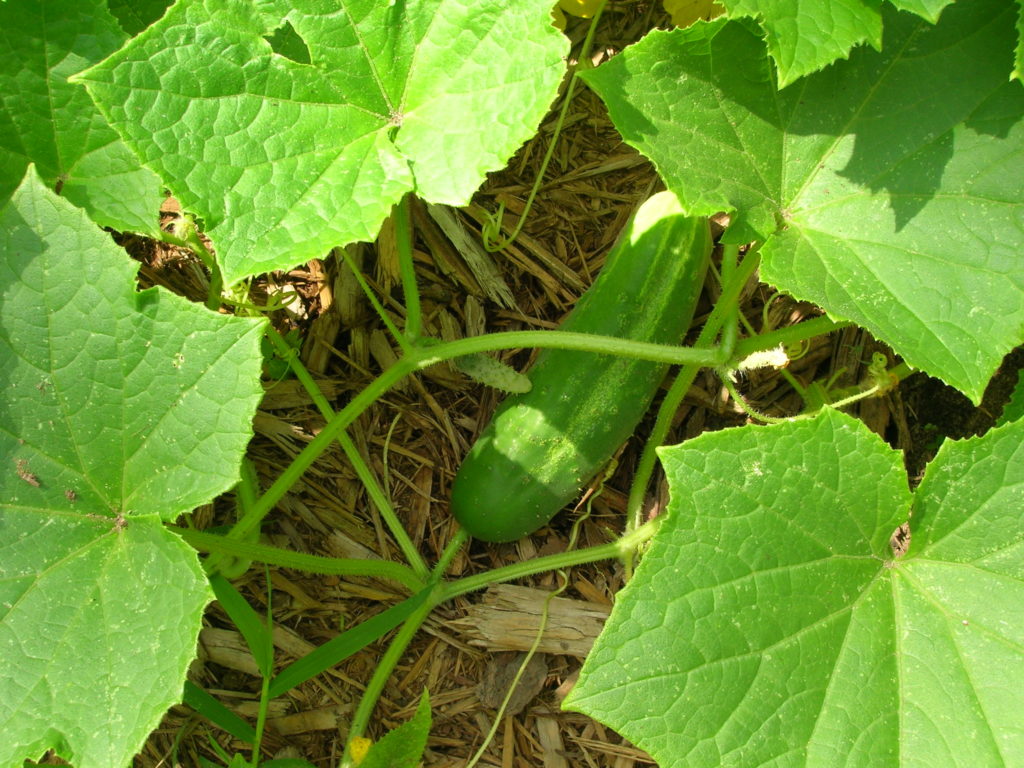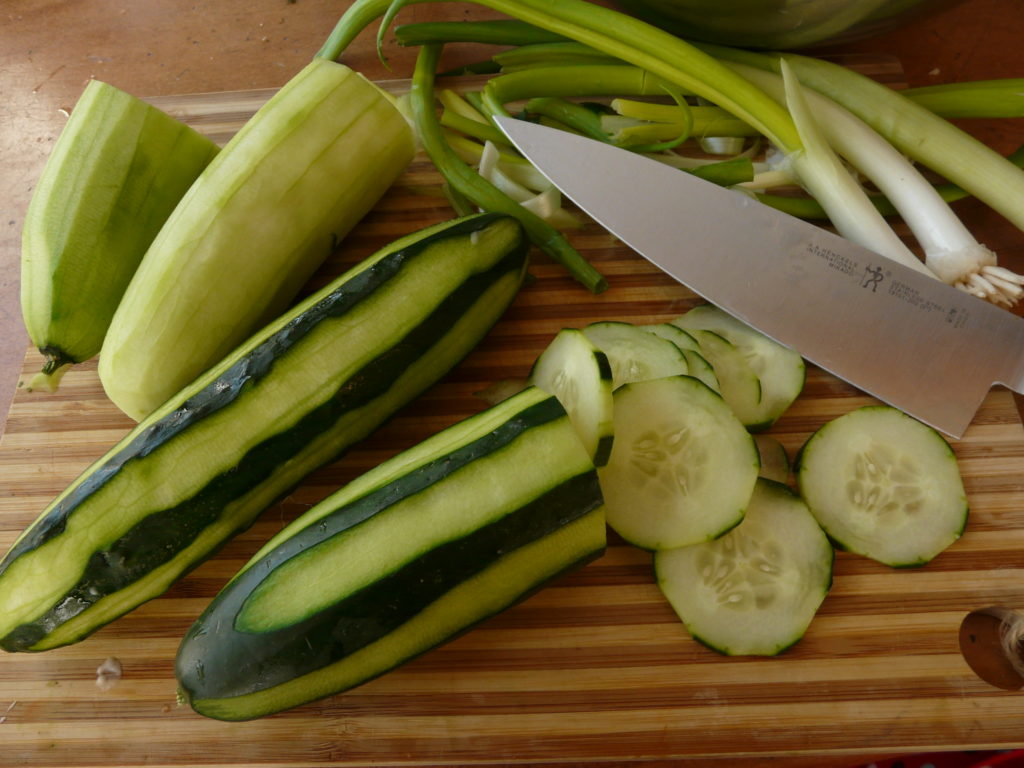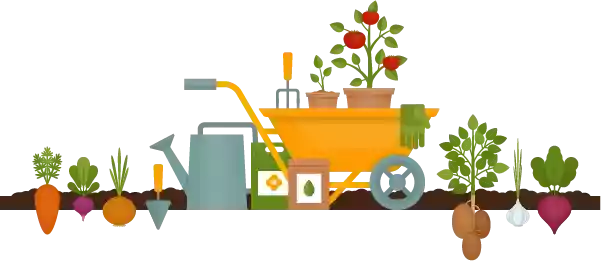Cucumbers are vine-grown fruits that are culinarily a vegetable and are closely related to squash and watermelons. They originate from India and were spread through Europe by the ancient Greeks and Romans. Cucumber is the fruit that becomes a pickle after undergoing a pickling process. Typically, the larger cucumbers are sliced and added to salads and other dishes, while the shorter fat cucumbers are pickled. Cucumbers can be eaten with or without the skin, but most thick-skinned cucumbers are enjoyed after peeling. Many grocery store quality cucumbers have a thin wax casing, which is another reason for peeling the skin off. Cucumbers are very low in calories but are packed with potassium, magnesium, vitamin C and K. There are a few types of cucumbers like the “picklebush” and “bush baby” that grow on bushes instead of the vine. These are better for small gardens or container planting.
Planting Cucumbers
 Cucumbers are annuals that require full sun and a mildly acidic soil 6.0 – 6.8 pH. As with most plants, the soil must be well drained to prevent rot. Cucumbers can be grown on trellises or without. Seeds should be sown 1 inch deep and spaced 12 inches apart if trellised, or 36 inches apart if not trellised. When starting from transplants, you will need to dig 3 inches deep, but the spacing remains the same as starting from seed.
Cucumbers are annuals that require full sun and a mildly acidic soil 6.0 – 6.8 pH. As with most plants, the soil must be well drained to prevent rot. Cucumbers can be grown on trellises or without. Seeds should be sown 1 inch deep and spaced 12 inches apart if trellised, or 36 inches apart if not trellised. When starting from transplants, you will need to dig 3 inches deep, but the spacing remains the same as starting from seed.
Since most cucumbers are grown from vines, adding a trellis to your garden is an easy way to aid their growth. A strong wooden or wire trellis at least two feet long will aid the vine as it grows and clings to it. Your soil should be loamy, composted, and well drained. You can also apply a 5-10-10 npk fertilizer to the soil. Seeds should be sown two weeks after the last frost has passed. Cucumbers can be grown in growing zones 3-11 but prefer warmer weather. Their ideal temperature is 75 to 85 degrees.
Some companion plants of cucumbers include corn and radishes. Radishes are perfect because they keep cucumber beetles away. Beans, sunflowers, and peas are also great companion plants for cucumbers.
Harvesting Cucumber
Regular slicing cucumbers should be harvested when they reach a length of about 8 inches and dills should be harvested when they’re 4-6 inches. It is important you harvest cucumbers before they turn yellow. Your cucumbers should be a uniform green and feel firm to the touch. If you leave your cucumbers on the vine for too long, they will grow too tough to enjoy and become bitter. Use shears to cut the cucumbers off the vine. Do not pull them off the vine as you risk the vine being damaged or no longer clinging to your trellis. Cucumbers will keep producing throughout the season, so keep your eyes open for freshly grown cucumbers after your first harvest.
Because cucumbers are mostly water, it is not a great idea to freeze them as it will damage the cell membranes of the cucumber. Cucumbers should be stored in the fridge for no longer than a week.

Troubleshooting Your Cucumbers
Cucumbers require pollination and require both the male and female flowers on the vine to cross pollinate. Inviting flowers to attract bees and other beneficial insects will aid in pollination. Too much rain or cold weather will slow down the pollination process. If possible, try and avoid using insecticides before pollination as that will detract bees from visiting your garden.
Anthracnose is a fungus that will cause the vines to turn yellow, brown, or black. Then, tiny little spots will form which develop into a gelatinous goop. Eventually the vines will rot. Copper-based fungicides or neem oil should help kill off any anthracnose if caught early.
Aphids will cause the vine leaves to curl and become twisted. They will also secrete a honeydew substance that will attract ants and leave black sooty mold. Apply an insecticidal soap, neem oil, or invite beneficial insects like ladybugs by planting native flowers.
Blossom end rot is very common in fruit and will leave large black rotted spots on the end opposite the stem. This is typically caused by the cucumber receiving too little water or insufficient nutrients from the soil. Make sure your soil is properly composted, well-drained, and has a proper pH balance.
Cucumber beetles will eat and leave holes in the vines of your cucumbers. They are known for carrying bacterial wilt which will cause your cucumber vines to wilt and die. Planting radishes near your cucumbers will help control the beetle population as well as apply insecticidal soaps and planting native plants to invite beneficial insects. Do not apply insecticidal soaps until the cucumbers begin to form or risk a lack of pollination required for the cucumber to grow.
Cucumber mosaic virus will cause green, yellow, or white ring spots to appear. Eventually the plant will grow warts and become distorted. There is no cure for mosaic virus, so the entire plant must be thrown out.
Downy or powdery mildew will leave a yellow or white cottony mold growing on your plants. Apply a copper-based fungicide or neem coil to control mildews.
Whiteflies will leave honeydew and sooty black mold, similar to aphids. This will cause wilting and stunting of the plants. Hang sticky yellow traps in your garden to catch the flies and apply insecticidal soaps.

Organize Your Cucumbers
The Garden Manager by Garden Savvy is the easiest way to keep track of your cucumber plants. Plan ahead and keep track of your slicing cucumbers and the ones you plan to pickle. Keep track of disease resistant varieties and hybrids you purchase each year so you know which ones to purchase the following years. The Garden Manager makes tracking your plants easy!












